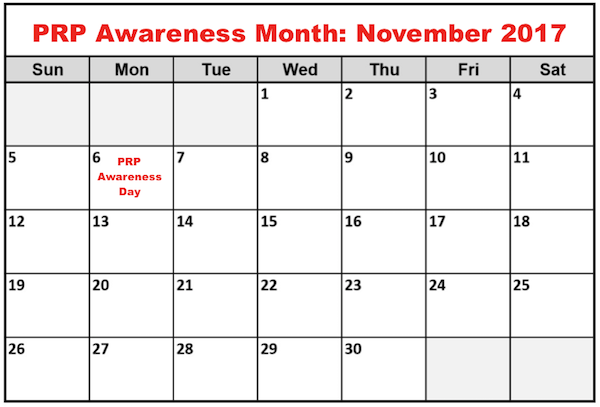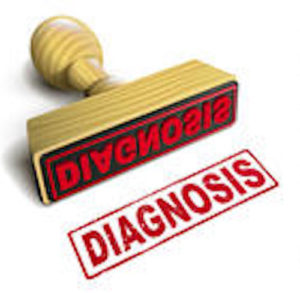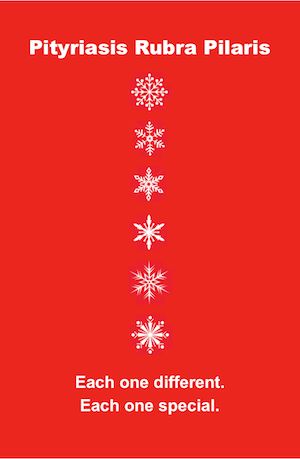My first PRP Awareness Day was November 28, 2012 and quite “unofficial” by any standards. It began with a phone call from my dermatologist’s office. I was told that the appearance of a red spot on my forehead on August 8 – nearly four months prior – had been the onset of pityriasis rubra pilaris. Like most PRP “newbies”, I spent the next few days searching the internet and learning what little there was to learn about PRP.
On November 1, 2013, I celebrated PRP Awareness Day once again. This time I sent out over 1,500 emails to PRP patients and caregivers and called the effort the PRP Worldwide Census. It had taken several months during the previous summer for me to review over 29,000 emails in the PRP Support Group Archive going back to 1997. As I collected email addresses I also “harvested” core information about the onset, diagnosis, and treatment of PRP.
 November 6, 2014 was the first “official” observance of PRP Awareness Day. The date was selected to commemorate the signing of the Rare Diseases Act of 2002 that set the threshold for a rare disease. To be considered a rare disease in the U.S. a disease must have a patient population of less than 200,000. With approximately 800 “active” PRP patients in the U.S., we qualify as über rare.
November 6, 2014 was the first “official” observance of PRP Awareness Day. The date was selected to commemorate the signing of the Rare Diseases Act of 2002 that set the threshold for a rare disease. To be considered a rare disease in the U.S. a disease must have a patient population of less than 200,000. With approximately 800 “active” PRP patients in the U.S., we qualify as über rare.
November 6-8, 2015 was the first PRP Awareness Weekend and November 2016 was the first PRP Awareness Month. Both “celebrations” had a common thread: each mobilized a predictably small cadre of dedicated PRP patient advocates who found a way get involved.
PRP Awareness Month 2017 has a relatively simple goal – to marshal the limited resources of the PRP community and make something meaningful happen in five areas:
❏½ Revive the PRP Community newsletter
❏½ Update the PRP Community Database
❏½ Out reach effort to the dermatology departments in 500+ teaching hospitals
❏½ Understand the role of dermatopathologists in the diagnosis of PRP
❏½ Support PRP research at Thomas Jefferson University
❏½ Publish a PRP Primer

Please review the six projects outlined below.
Your feedback is a appreciated.

1. PRP Newsletter: On The Road…
 Objective
Objective
To resurrect the PRP community’s original newsletter. A total of 24 issues (598 pages) of On the Road … Our Journey from Onset through Remission were published during the period April 2014 through October 2015.
Problem to be addressed
The PRP Alliance does not “push” information to the PRP community. We depend on PRP patients and caregivers to reach out via the the PRP Facebook Support Group with questions (posts) and access the PRP Survival Guide and PRP RareConnect Community and on a need-to-know basis.
Scope
The reformatted online newsletter will present a synopsis/overview of articles with links labeled READ MORE or FULL STORY. Topics will include:
❏½ Diagnosing PRP
❏½ Treating PRP
❏½ Daily Life
❏½ PRP Parents and Children
❏½ PRP and Remission
❏½ PRP Research
❏½ PRP Advocacy
Methodology
The PRP Community will utilize Constant Contact to provide a weekly or bi-weekly update on issues related to the PRP.
Measuring Success
Success will be measured by the following:
❏½ Our ability to publish 26 or 52 issues during the period November 1, 2017 through October 31, 2018.
❏½ Increased number of subscribers
2. 2018 PRP Worldwide Census
 Objective: To conduct a PRP Worldwide Census.
Objective: To conduct a PRP Worldwide Census.
Problem to be addressed: The PRP Community Database currently tracks 1,584 PRP patients of which 651 (41%) are members of the PRP Facebook Support Group and 217 (14%) are members of the PRP Community on RareConnect. Unfortunately, the following information is currently missing.
❏½ Missing email addresses: 557
❏½ Missing locations: 468
❏½ Missing onset dates: 868
❏½ Missing onset ages: 933
❏½ Missing diagnosis dates: 889
❏½ Missing status: 927
Methodology: Use the technical resources of Constant Contact to solicit and protect information.
Financial Impact: The out-of-pocket costs associated wth the conduct of the 2018 PRP Worldwide Census are limited to a monthly prescription which provides for an unlimited number of surveys.
❏½ Vendor: Constant Contact
❏½ Subscription: $47.97 per month; $575.64 annual
Measuring Success:
❏½ Reduction is the number of missing data points
❏½ Increased membership in the PRP Facebook and RareConnect communities
❏½ Identification of undeliverable email addresses.
❏½ Creation of charts and tables
3. PRP Dermatology Awareness Initiative

Objective
To conduct a outreach effort the dermatology departments of 500 teaching hospitals in the US.
Problem to be addressed
When a patient is diagnosed with PRP, the dermatologist – with rare exceptions – does not refer the patient to the PRP Alliance, PRP Facebook Support Group, the PRP Community on RareConnect or to the PRP Survival Guide. The PRP patient is typically referred to Dr. Google, Dr. Yahoo or Dr. Bing.
Scope
There are over 500 teaching hospitals in the U.S. with a dermatology department that includes faculty, clinicians, support staff and medical students. The PRP Referral Outreach Program will advocate referral to the Genetic and Rare Diseases Information Center (GARD).
Methodology
This effort requires two First Class mailings to 500 teaching hospitals and a personal followup by a local PRP patient.
Mailings
(1) Execute mailing to the list on Wednesday, October 18, 2017
(2) Execute mailing to the list on Wednesday, November 1, 2017 to commemorate the start of PRP Awareness Month 2017.
Personal followup
(1) Target 50 Departments of Dermatology at teaching hospitals in the U.S. where members of the PRP Facebook community are (a) currently being treated or (b) are within reasonable geographic proximity.
Measuring Success
The dermatology departments at teaching hospitals will be given the opportunity to “acknowledge and/or confirm” the efficacy of referring of patients with rare skin disorders to the Genetic and Rare Diseases Information Center
4. PRP Research
 Objective
Objective
To inspire and support PRP research efforts globally.
Problem to be addressed
It is critical that the PRP community participate in PRP research (ongoing and future)
Scope
Recruiting participants for research efforts associated with
❏½ Thomas Jefferson University (Philadelphia, PA),
❏½ Yale University School of Medicine (New Haven, CT),
❏½ Oregon Health & Science University (Portland, OR) and the
❏½ International Alliance of Dermatology Patient Organizations (Ottawa, Canada)
Methodology
❏½ Integrate the recruitment of research participants within the PRP Worldwide Census effort.
❏½ Raise funds to reimburse participants in genetic research at TJU for costs associated with supplying blood samples
Measuring Success
Success will be measured by the number of participants in ongoing and future PRP research.
5. Diagnosing PRP Tutorial
 Objective
Objective
To better understand the role played by dermatopathologists in the diagnosis of PRP.
Problem to be addressed
While some PRP patients enjoy a relatively quick diagnosis of PRP, many of us have had to suffer through a differential diagnosis that preceded the “official” PRP diagnosis. During that time either the wrong treatment was administered or the appropriate treatment delayed. Understanding the diagnosis of PRP would seem to be an important part of our journey from onset to remission,
Scope
Clinical observation of signs and symptoms
Biopsies and evaluation by dermatopathologists
Methodology
The first challenge is to locate one or more dermatopathologists who want to help write a lay language tutorial about the challenges of diagnosing a rare skin disorder, in general, and PRP in particular.
❏‘ American Society of Dermatopathology (ASDP)
❏‘ Ameripath
❏‘ Aurora Pathology
❏‘ Carepath DX
❏‘ Clinical Pathology Associates
❏‘ Cockerell Dermatopathology
❏‘ Dermpath Diagnostics
❏‘ Journal of Cutaneous Pathology (JCP)
❏‘ Miraco Life Sciences
❏‘ ProPath Dermatopathology
❏‘ Stanford Medicine Dermatopathology Service
❏‘ Quest Diagnostics
❏‘ UCSF Dermatopathology and Oral Pathology Service
Measuring Success
There are three deliverables– all to coincide with PRP Awareness Month 2017.
❏½ Tutorial – Magazine format, downloadable PDF
❏½ PowerPoint – Same information as the tutorial, but an alternate format
❏½ Webinar – Combination of the PowerPoint and an interview with a dermatopathologist.
6. PRP Primer – eBook

Objective
To repurpose the NORD PRP Report (revised 2017) as an eBook to coincide with Rare Disease Day (February 28, 2018).
Problem to be addressed
PRP patients and caregivers, family and friends, employers and coworkers, classmates, teachers , administrators and parents, and other healthcare professionals need access to information about PRP. The information must be easy to access, easy to read and easy to understand.
Scope
The eBook will follows the organization of the PRP Survival Guide.
❏½ PRP Basics
❏½ Diagnosing PRP
❏½ Treating PRP
❏½ Daily Life
❏½ PRP and Remission
❏½ PRP Research
❏½ PRP Advocacy
Methodology
Take the NORD PRP Report and put more “meat on the bone” with extra pages and sidebars.
❏½ PRP Patient Profiles
❏½ Random stories
❏½ Humour
❏½ Expanded technical information
❏½ Healing milestones
❏½ Coping strategies
Measuring Success
Success will not be measured by the number of people who download the eBook during the period February 28 to November 30, 2018.. Success will be measured by actually publishing the eBook. This may be the “giveaway” for donations made to the PRP Alliance or to a special PRP-related project.

PRP Awareness Month Planning
This is an automatic translation service and therefore the
PRP Survival Guide is not responsible
for any potential translation inaccuracies.
